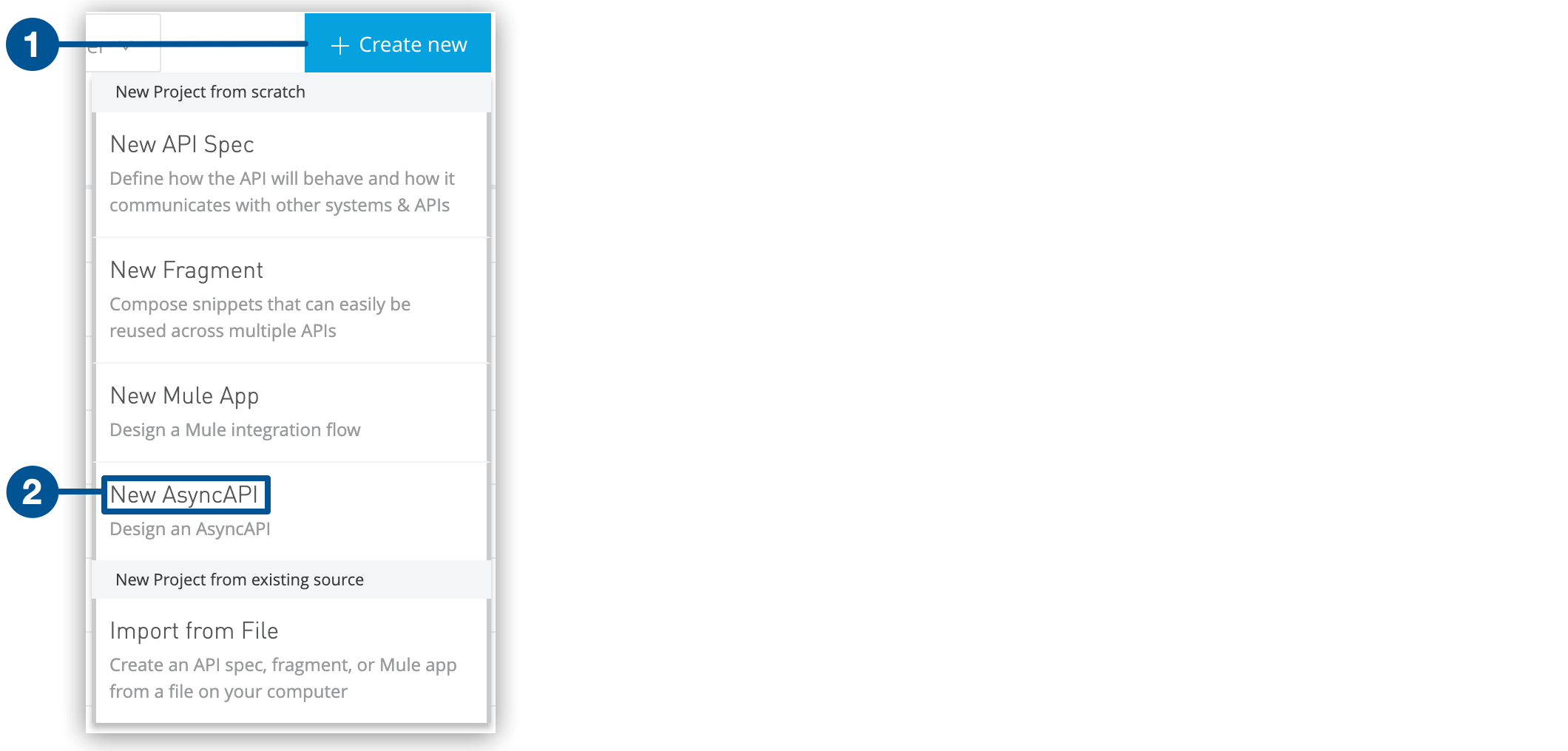Design
Event-Driven API (AsyncAPI) Support Release Notes
October 14, 2021
Event-driven API is supported in Anypoint Platform through AsyncAPI. You can publish AsyncAPI specifications to share with partners, customers, and developers.
AsyncAPI Support in Anypoint Platform
AsyncAPI is supported by the following products in Anypoint Platform:
| API Lifecycle Stage | Product | Additional Information |
|---|---|---|
API Designer |
You can create an AsyncAPI specification or import one from Anypoint Exchange. |
|
Publish |
Anypoint Exchange |
You can add non-managed instances to your AsyncAPI asset in Anypoint Exchange. |
| Anypoint Studio and Flow Designer do not support AsyncAPI. If you open an AsyncAPI specification or asset in one of these tools, an error message is displayed. |
Work with AsyncAPI Specifications in API Designer
You can create or import your AsyncAPI specifications in API Designer and then edit, document, and publish them.
AsyncAPI is a language that describes messaging interfaces. This open-source, industry-standard language is agnostic to any technology. To learn more, see the AsyncAPI documentation.
AsyncAPI makes it easy to work with event-driven architecture by separating the API into three layers:
-
Events: Message or data to be shared with other services
-
Channels: Destination of the message to be sent or received
-
Transport: Technology that transports the message, such as RabbitMQ, Kafka, or Anypoint MQ
You can create or import an API specification in API Designer.
To create an AsyncAPI specification in API Designer:
-
In Design Center, click Create New.
-
Select New AsyncAPI.

To import AsyncAPI specifications from Anypoint Exchange or from your filesystem:
-
Click the gear icon at the top right of the text editor.
-
Select from the following options:
-
Select Import from Exchange to see the following lists:
-
API specifications that are available from the business organization that your user ID belongs to in Anypoint Platform
-
API specifications that are published by MuleSoft
-
-
Select Import to import an API specification from your local filesystem.

-
-
As appropriate, continue to work with your AsyncAPI specification in API Designer:
-
Develop and edit AsyncAPI specifications.
-
View documentation that is included in AsyncAPI specifications.
-
Publish AsyncAPI specifications to Anypoint Exchange.
-
Example AsyncAPI specification
Following is an example that you can copy into API Designer to get started with event-driven APIs.
This example is a typical event-driven process that is documented for easy reuse. It has a service with two channels, one that books the trade and another that gets the result of the booking asynchronously.
Sections in the example specification are:
-
AsyncAPI
Identifies the API model as AsyncAPI and specifies the title and version of the API spec.
-
Channels
-
The book_trade channel enables you to specify the buy/sell order, symbol, and number of shares you would like to purchase.
-
The trade_result channel returns the result of the transaction.
-
To try the example, create a new AsyncAPI specification in Design Center and copy the following code directly into API Designer:
asyncapi: 2.0.0
info:
title: Async Request/Trade API
version: 0.1.0
channels:
book_trade:
publish:
message:
payload:
type: object
properties:
trade-id:
type: integer
minimum: 0
description: the order id of the message coming
trade-symbol:
type: string
minimum: 0
Description: ticker symbol of the stock.
trade-type:
type: string
format: string
description: BUY or SELL
trade-amount:
type: number
format: float
description: the number of shares to be traded.
trade_result:
subscribe:
message:
payload:
type: object
properties:
trade-id:
type: integer
minimum: 0
description: the order id of the message coming
trade-symbol:
type: string
format: string
description: ticker symbol of the stock.
trade-time:
format: date-time
description: date and time of the order.
trade-amount:
type: number
format: float
description: the number of shares to be traded.
trade-type:
type: string
format: string
description: BUY or SELL
trade-status:
type: string
format: string
description: PENDING, PROCESSED and FAILED
For documentation on using API Designer to work with your specification, see API Designer.
Work with AsyncAPI Specifications in Anypoint Exchange
After you publish your AsyncAPI specifications to Exchange, you have visibility into them as you would with other types of APIs. API authors can also add the instances that are serving the APIs.
Because AsyncAPI instances are not managed by API Manager, they are called non-managed instances.
To add non-managed instances in Exchange:
-
Select the AsyncAPI asset.
-
At the bottom left of the navigation, select API Instances.
-
Click Add non-managed instance.
-
In the API Instances page, click Add new instance.
-
Enter the instance that is serving your API and its URL.
For more information about configuring API instances in Exchange, see Configure API Instances.



